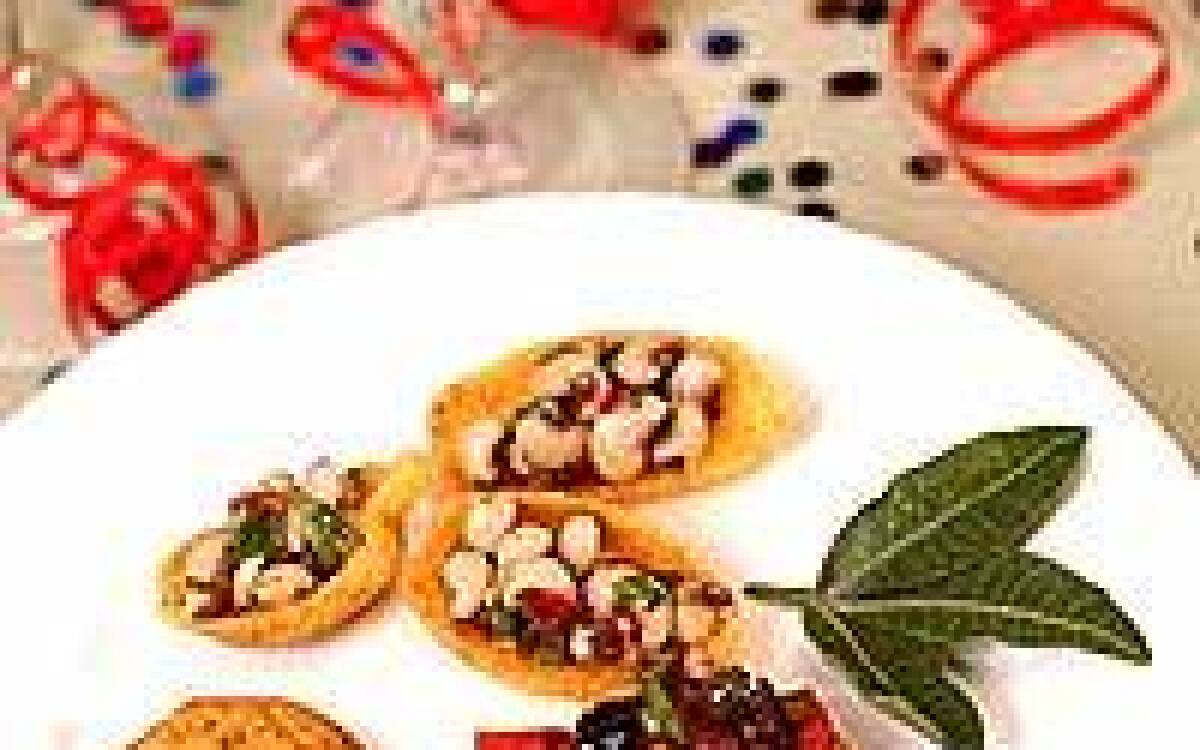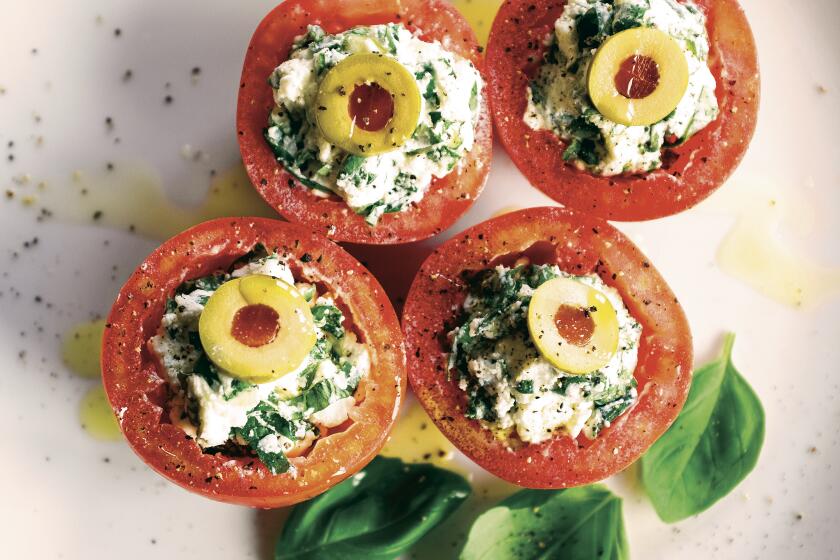Olive-anchovy pepper wedges

- Share via
Somewhere along the line, book publishers apparently decided that entertaining is like sex. It needs a manual.
This season, they have produced quite a few, each more fantasy-filled than the next. And while even the most experienced drink mixer and canape maker can always use a new technique, these new soft-focus entertaining books actually seem designed to dampen any desire to ever give a party.
Do you really need a bar stocked with every proof, color and flavor of alcohol, let alone six styles of glassware and 14 garnishes? Does the menu have to include such hors d’oeuvres as chawan-mushi eggs (Japanese custard served in a shell sliced off with a special “egg topper”)? Can you really not decorate a table without using more candles than St. Peter’s?
I know my way around the punch bowl, but in planning my New Year’s party, I was seriously intimidated after flipping through such slick books as “Cocktail Parties With a Twist” and “Dinner After Dark” and even the seemingly inviting “At Home With Friends.” Each is filled with page after page of either too-gorgeous-to-be-real food or too-happy-to-be-normal skinny people brandishing drinks and forks and having the camera-loving kind of fun you never see at real parties. These books set the limbo bar pretty high.
So, after poring over all the latest advice from the pros, I have happily gone back to a game plan developed over many amateur hours on New Year’s. It’s worked for as few as 12 guests and as many as 125. It’s worked when I was caged in a life-consuming job and when I was footloose and pension-free, freelancing with all the time in the world to plan and shop and cook. And mostly it’s worked because I’ve done what felt right for me. None of the professional hosts in the glossy books ever lets on that you can have a fine time with wine only, or with one designated drink, like the Swedish glogg that my consort and I have appropriated as our liquid welcome to the new year. Or that you can dazzle guests with really simple food, whether an artisanal ham or a big bowl of black-eyed peas, as long as there is meaning behind it.
Even the books that repeat “keep it simple” like a mantra contradict themselves with photos and recipes and lists -- like the one for “what every home bar should have” that insists on a muddler to bruise the mint for mojitos. The only acquisitions you should have to make should be dish-specific: a tall stockpot to simmer the glogg, say, or heavy-duty foil for covering that ham as it heats.
Worse, while book hosts all insist that you plan ahead, their recipes inevitably end with the same instruction: “Serve immediately.” What host can stand facing the stove all through the party, shuffling sheet pans in and out of the oven?
Answer: Not me.
From my very first serious New Year’s party, in 1984, I have been convinced that the last line in the very best recipes is: “store up to three days.” Any cooking done in advance is like reassurance in the bank.
I used to spend a week assembling only appetizers to avoid having to deal with silverware. Everything was chosen because it could be made in party quantities with minimal effort and would hold up until the doorbell rang. Life got simpler once I developed more of a three-course menu: a few finger foods to get things going, a big centerpiece such as ham with some side salads, and one or two sliceable desserts such as cake or pie along with several plates of cookies. Bars are best: One big pan yields 36.
I’ve always given my New Year’s party on the day, not the eve. (For some reason, guests seem to remember afternoon parties better, plus it leaves me free to see the fireworks at midnight.) But the menu would fit either time slot. Anyone who comes intending to stick around until the ball drops will go away satisfied without a sit-down dinner, and anyone stopping by an open house the next afternoon could fill up on a plate of food or just a few cookies on the way to the movies.
Because alcohol rears its potent head no matter what time of day it is between Dec. 31 and Jan. 2, I always think rich. The New Year’s Eve menu outlined in one new book might be over the top -- caviar, lobster bisque, salmon, cheesy spinach dumplings with cream sauce, strawberry cheesecake and, apparently, gout -- but this is not an occasion for light eating.
You could just set out a big cheese tray, but I think that’s cheating. Cheddar should be transformed, not just sliced. Mix it into a dough with jalapenos and pimentos and you can make crisp little wafers that are like cheese straws without the breakage. Melt it with equal parts mayonnaise and chopped Vidalia onion and you get a sensational hot dip for chips.
For all my aversion to store-bought party food, I have taken to investing in a seriously great ham to hold down the buffet table, partly because it buys me time to concentrate on the other dishes but mostly because no one but our vegan friends can resist it. For them, there are other choices alongside the offending meat, usually salads or oversize savory tarts cut into squares or a meaty-tasting bean salad. Ham is also good because people will eat it any way they can: standing up or sitting down, by the slice with their fingers, on bread with mustard or just in little chunks off toothpicks. (Gravlax or a side of smoked salmon is almost as good.)
However, my favorite food is anything you can eat with no forks, which is why I’m also partial to such two-bite ideas as red pepper wedges baked under a chunky garlicky blend of capers, olives and anchovies, or slivers of a classic Spanish tortilla, thick with potatoes and onions and rich with olive oil.
And because the theme of my party is always good luck for the New Year, I make anything I can with black-eyed peas: salad, or a bean spread with pancetta and artichokes or, especially, Texas “caviar,” with the peas marinated with chiles, cilantro and scallions. The chiles are usually jalapenos, but chipotles add more heat along with a smokier flavor. The longer the black-eyed peas sit in the refrigerator and the seasonings, the better they get. You can eat them daintily with a fork or messily like a salsa, on rounded corn chips.
We set out most of this food on our dining room table but scatter things like the Cheddar wafers around the living room and in the kitchen near the stove with the glogg to keep people moving and eating. My usual aim is to have it all waiting, rather than wasting the first hour of the party sweating over a hot sheet pan. Parties are always more fun if I get to attend.
Next Wednesday, the food is going on paper plates, with our best plastic flatware. (I will happily spend a week cooking but not more than a couple of hours cleaning.) The glogg will be ladled into Greek diner-style “We Are Happy to Serve You” paper mugs from a restaurant supply house (the ultimate combination of disposability and conversation piece). The lighting will be by nature, the music by whoever hits the CD player first.
And while there will be a photographer, he’s the host and will be focusing only on the drinks.
Heat the oven to 375 degrees. Lightly oil a shallow baking dish and arrange the pepper wedges in it in a single layer, hollow sides up.
Stir together the olives, garlic, parsley, anchovies, capers, tomatoes and pepper flakes in a small bowl. Season with pepper to taste. Add more of any ingredient to taste; if mixture is too dry, add a bit more chopped tomato.
Spoon a little of the mixture into each pepper wedge. Drizzle with olive oil. Cover the pan with foil and bake 20 minutes. Uncover and bake until the peppers are soft, about 10 minutes longer. Serve at room temperature.
Get our Cooking newsletter
Get a taste of Los Angeles — and the world — with recipes and kitchen tricks from the L.A. Times’ Cooking newsletter.
You may occasionally receive promotional content from the Los Angeles Times.















